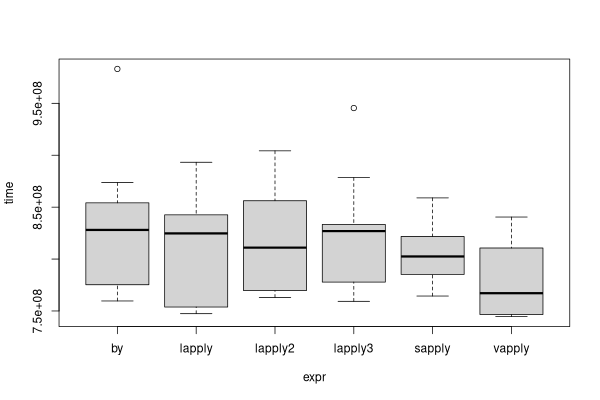Faster than R's `simplify2array`?
I often have code that looks like
rbind.oc.by <- function (indata, INDICES, FUN, ...) {
result <- by( indata, INDICES, FUNIN, ... )
t(simplify2array(result))
}
mynewdata <- rbind.oc.by( dataframe, dataframe$variable, function(dd) { with(dd, ... } )
So, I am testing it out:
set.seed(0)
if (!exists("X")) {
X <- lapply( 1:10000000, function(i) {
c(a=rnorm(1), b=rnorm(1), x="A", y= as.logical(rnorm(1)))
})
}
## R CMD Rprof testprof.out
Rprof("testprof.out")
intimealloc <- function() {
as.data.frame(do.call("rbind", X))
}
v1 <- intimealloc()
firstalloc <- function() {
simplify2array( t( X ))
}
v2 <- firstalloc()
Rprof(NULL)
simplify2array() is pretty good, about 8 times faster than do.call("rbind"). yet, I am still wondering whether there is a way to write a faster specialized version of simplify2array() that relies on the fact that results are either NULL or all the same data frame. presumably not, but I thought I would ask.
You could try unlist() |> array() |> t() to remove possible overhead (see lapply2 below) or or unlist() |> matrix(byrow=TRUE) to avoid transposing (see lapply3). However, instead of by() you could use split() |> lapply() |> simplify2array() |> t() or split() |> sapply() |> t(), since sapply() is like lapply() with integrated simplify2array(), or vapply():
Benchmark
$ Rscript --vanilla foo.R
Unit: milliseconds
expr min lq mean median uq max neval cld
by 759.6597 775.2684 833.4783 828.0770 854.1466 983.1176 10 a
lapply 747.4017 753.7931 812.9594 824.6948 842.5910 893.2388 10 a
lapply2 763.0132 769.7017 819.1545 811.0160 856.1791 904.2550 10 a
lapply3 759.2881 777.8115 822.4855 826.9304 833.3351 945.4514 10 a
sapply 764.3702 785.1906 805.3541 802.4946 821.7591 858.9353 10 a
vapply 744.5296 746.5801 780.0658 767.1196 810.6612 840.4624 10 a
It just depends on what exactly you do in *apply() and whether the tradeoff is beneficial for writing custom code.
Code
set.seed(42)
mtcarsh <- mtcars[sample.int(nrow(mtcars), 1e6, replace=TRUE), ]
n <- length(unique(mtcarsh$am))
m <- ncol(mtcarsh)
microbenchmark::microbenchmark(
by=by(mtcarsh, mtcarsh$am, colMeans) |> do.call(what='rbind'),
lapply=split(mtcarsh, mtcarsh$am) |> lapply(colMeans) |> simplify2array() |> t(),
lapply2=split(mtcarsh, mtcarsh$am) |> lapply(colMeans) |> unlist() |>
array(c(m, n), list(colnames(mtcarsh), unique(mtcarsh$am))) |> t(),
lapply3=split(mtcarsh, mtcarsh$am) |> lapply(colMeans) |> unlist() |>
matrix(c(n, m), byrow=TRUE) |> `dimnames<-`(list(unique(mtcarsh$am), colnames(mtcarsh))),
sapply=split(mtcarsh, mtcarsh$am) |> sapply(colMeans) |> t(),
vapply=split(mtcarsh, mtcarsh$am) |> vapply(colMeans, FUN.VALUE=numeric(m)) |> t(),
check='equal', times=10L
)
- Create a Grouping Column/Variable from other Columns in R
- Specify the height of the bars in the gglikert function in R
- modelsummary modelplot: change linewidth
- How to create a conditional panel using a reactive object that is passed from another module?
- renderHighchart output not displaying in Shiny App
- How can I specify GeoTiff configuration of PixelIsPoint when exporting a raster using R package terra?
- Create a list from a dataframe in R
- Fast way of converting large list to dataframe
- rintrojs only shows first dialog in Safari
- Automatically read a column of lowercases True and False as logical
- How do I add counts to a stacked bar graph?
- Counting the number of rows between each pair of months?
- Plot multiple normalized stock charts from different dates into a single plot
- Select columns based on string match - dplyr::select
- Looking for a more efficient way to replace matrix elements
- custom R function with group argument does not work while using the filter
- ggsurvplot function, risk table alignment problem
- plot running average in ggplot2
- Calling variable in df within function
- How to find position of running minimum (runMin) in a vector in R?
- Using httr2::last_response() in conjunction with purrr::possibly()
- Cropping a raster using terra does not return the expected extent
- Can janitor::clean_names be used on only certain columns in a data frame?
- Efficient way of row binding time series in a data.table, with correctly sorted timestamps
- Defining optional arguments in R when more complex function
- Can I change the cursor in plotly only when hovering over points?
- Issue Loading RStoolbox: "Cannot find proj.db" Error
- Filter CSV files for specific value before importing
- Matching the same lines from 2 different files and 2 columns
- Conditional coloring and outer borders in pdf KableExtra table in R
